By: Matt Teegarden
Ahh Fall. It’s a glorious time of year that conjures thoughts and memories of colorful leaves, football, and Halloween. A lot of focus is on everything pumpkin spice this time of year…almost too much focus. Don’t get me wrong- I love the occasional pumpkin spice latte and the more-than-occasional pumpkin spice Oreo, but there are other fall flavors and indulgences that deserve just as much attention.
So let’s talk apples.
It seems like just about every time autumn rolls around, I get unreasonably excited to eat sweet and delicious Honeycrisp apples that also tend to be unreasonably priced. However, on a recent trip to the grocery, I stood at the edge of the produce section in disbelief for two reasons: one- Honeycrisp apples were $1.25/lb, and two- there was someone buying red delicious apples when Honeycrisps were so cheap. HOW COULD YOU DO THAT TO YOURSELF?! Realizing that I have no right to tell people how to live their lives or buy their apples, I decided to bag my own and carry on.
According to the USDA National Agricultural Statistics Service, the United States produced over 10.4 billion pounds of apples last year with the state of Washington contributing over half of that total. Now, that is a lot of apples, but it is important to remember that all of this is not being delivered as fresh produce right away. Much of it is likely stored for distribution throughout the year and for other apple-derived products.
Of course, there have been some news and sensationalist blogger articles poo pooing the industry for this long-term storage practice- mostly because they are concerned about the potential impact that storage will have on the antioxidant capacity of the fruit. As food scientists we know that apple producers don’t just slap apples into giant refrigerators for storage- they are stored in controlled environments meant to maintain the fresh quality and safety of the produce. In fact, a quick search led me to a few articles citing meager-if any- decrease in antioxidant activity or antioxidant compounds in stored apples (1,2). But I digress…
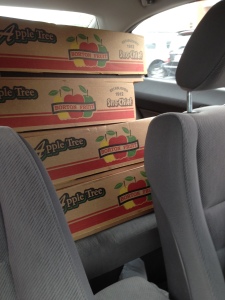
Apple scented car air freshener
To celebrate the cheapest Honeycrisp prices we have ever seen, and to gain some practical food processing experience, some friends and I decided to buy 100 lbs of the apples and make cider. Here is a tip- if your car smells like old gym socks, keep 100 lbs of Honeycrisp apples in your back seat for two days. Their sweet perfume will permeate your upholstery, and it will smell like you have a small apple orchard hidden in your Civic.
The cider making process was rather simple. We first milled the apples and then, in several batches, pressed them in a small manual screw press.
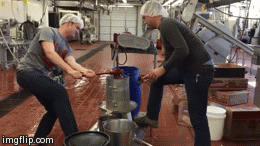
Pressing Apples for Cider
Of course, not all apples are destined to be made into cider. There are comprehensive lists that describe the best uses for several apple varieties. Apples have beendomesticated and produced for over 2000 years, and there are literally over 10,000 named cultivars in existence (3), so such lists cannot be comprehensive. I have no doubt that good cider-making apples provide a high juice yield and have ideal polyphenol oxidase activity to create the rich brown color, characteristic of the drink.
So please join me in celebrating the apple! To help us pay tribute, IFTSA President Jay Gilbert has shared with us one of his favorite family apple recipes. Be sure to share your favorite recipes and apple varieties in the comments below!
Hot Apple Pastry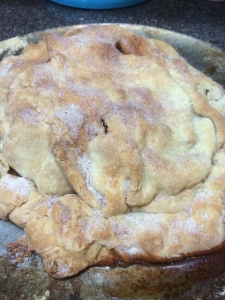
From: Jay Gilbert
This Hot Apple Pastry has always been a popular dessert for my whole family to make. It is a simple twist on the classic apple pie (it feeds a lot more people too!). And if you want to talk about a twist…whenever my grandmother would make this (or anything apple), she would always remind us about the simple pleasures in life by repeating her and my grandfather’s favorite saying: “An apple pie without cheese is like a kiss without a squeeze”. So break out the cheddar!
Pastry
– 2.5 cups flour
– 1 tbsp sugar
– 1 tsp salt
– 1 cup shortening
– 1 egg (beaten)
– 2.3 cup milk
Mix flour, sugar, and salt. Cut in shortening with pastry blender. Mix beaten egg and milk, add to flour mixture and mix well with a fork to form a soft dough. Shape into a ball and wrap in plastic wrap. Refrigerate for 30 minutes.
Filling
– 2/3 cup corn flakes (crushed)
– 8 cups sliced apples (this can be adjusted depending on how much filling you want/like)
– 1.5 cup sugar
– 1.5 tsp cinnamon
– Sprinkle of nutmeg
Roll out half the dough onto a greased baking sheet. Sprinkle pastry evenly with corn flake crumbs. Then layer with apples. Combine sugar, cinnamon, and nutmeg and mix well. Sprinkle over apples. Roll out the other half of dough and lay over apples, crimping the edges. Cut a few slits in the top of the crust and sprinkle with a bit of sugar. Bake at 400 °F for 40 minutes.
References
(1) van der Sluis AA, Dekker M, de Jager A, Jongen WMF. 2001. Activity and Concentration of Polyphenolic Antioxidants in Apple: Effect of Cultivar, Harvest Year, and Storage Conditions. J Agric Food Chem. 49:3606-3613.
(2) Napolitano A, Cascone A, Graziani G, Ferracane R, Scalfi L, Di Vaio C, Riteni A, Fogliano V. 2004. Influence of Variety and Storage on the Polyphenol Composition of Apple Flesh. J Agric Food Chem. 52:6526-6531
(3) Hampson CR, Kemp H. Characteristics of important commercial apple cultivars. 2003. In: Ferree DC, Warrington IJ, editors. Apples: botany, production and uses. Cambridge, MA: CABI Publishing. p61-89.
Cover image: www.wordpress.com


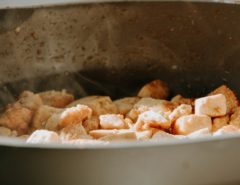
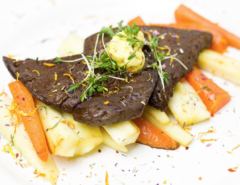

Leave a Reply